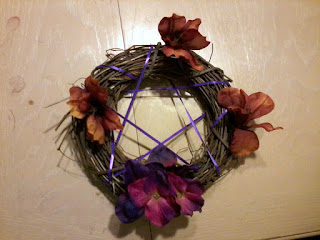One of the most important texts for modern
druids to study may be the Colloquy of the Two Sages, the tale of a
confrontation between the esteemed Druid Ferchertne and the recently graduated
student Nede. The tale, on its surface, is a simple story of a confrontation
sown by Bricriu between the elder and the youth after Bricriu convinces Nede,
who is returning from training over seas, to seize a rank beyond his
experience. The two Druids face off over the literal seat of contention,
engaging in a battle of words and wits to test who truly deserves to sit there.
In the end Ferchertne emerges the victor, but Nede’s graceful defense earns him
a place as Ferchertne’s student.
Reading this story establishes a pattern
of challenge and response that is useful for all modern Druids to study. Nede’s
initial actions are bold, even arrogant, as he assumes the chair of the highest
ranked Druid in the land and this can be seen as the opening challenge in the
coming confrontation. Nede does not approach Ferchertne as a humble petitioner,
but rather by declaring his own value and assuming a place as if it were
already his own. In response we see the first of Ferchertne’s challenges, not
only of words but of actions and attitude as he tests Nede’s resolve and temper
by speaking angrily and insulting Nede’s experience and knowledge. Nede passes
this challenge by responding calmly and proclaiming his own wisdom. This, then,
sets the stage for the next phase of the testing the direct question, where
Ferchertne asks Nede where he is from, what his name is, what art he practices,
what his tasks are, by what path has he come, whose son he is, and what tidings
there are. None of these are direct, literal questions, but all are allegorical
and are responded to with poetry, and each question is answered and then turned
back on the elder Druid. It is only after the final question, where each man is
asked to prophecy, that Nede concedes to Ferchertne and willingly proclaims him
the better poet and seer and kneels at Ferchertne’s feet, at which point the
older Druid asks the younger to stay on as his student. From this we can see
that the importance of the period of questioning and answering as a form of
testing, as well as the importance of the final acknowledgements of the
student’s true place.
In modern Druidism this pattern of
challenges could be used to model actual initiation rites on; it also
illustrates the vital importance of two elements within modern traditions: the
student-teacher relationship, and the hierarchy of wisdom. The traditional
Druidic model of teaching, as illustrated in this Colloquy, shows a student
petitioning to study with a teacher, studying with that person for as long as
there is knowledge to be gained there, and then moving on to find a new
teacher. This is illustrated in Nede’s studying at first with Eochaid in
Scotland and when that teacher can teach him no further he is sent back to
Ireland where the main action of the tale between Nede and Ferchertne occurs.
This is a useful model to be used today as well. The story also illustrates the
importance of understanding our individual place within the greater hierarchy
of our fellow Druids and both respecting those above us as well as teaching
those beneath us.
I, personally, found a great deal of
beauty and inspiration in this story. The question about what art they practice
gives a list of the many skills the Druids claimed including satire, blessing,
poetic inspiration, storytelling, peacemaking, and teaching wisdom. The tale
also showed me something of the proper balance of attitude that Druids were
expected to have, both proud and assertive but also respectful and quick-witted
in the face of confrontation. Nede serves as a great model to meditate on as
student who is well on the way to earning fame and a place of honor. I can hold
Nede before me as an example of how to react to a challenge and how to carry
myself with pride while still remaining respectful of those wiser than I.
On a final note the Colloquy is also a
treasure trove of cultural references and Druidic lore that anyone interested
in Druidism should take the time to study. I favor Christian Guyonvarc’h’s book
The Making of a Druid: Hidden Teachings from the Colloquy of the Two Sages because
of the detailed and extensive introduction, notes, and appendices. Being able
to study the story with the different translations and glosses included is very
useful and illuminating and offers additional insight into some of the passages.
These additions, such as the extensive discussion about the seven poetic grades,
are an important aspect to understand for both Druids and Celticists, or anyone
else interested in Irish culture.




